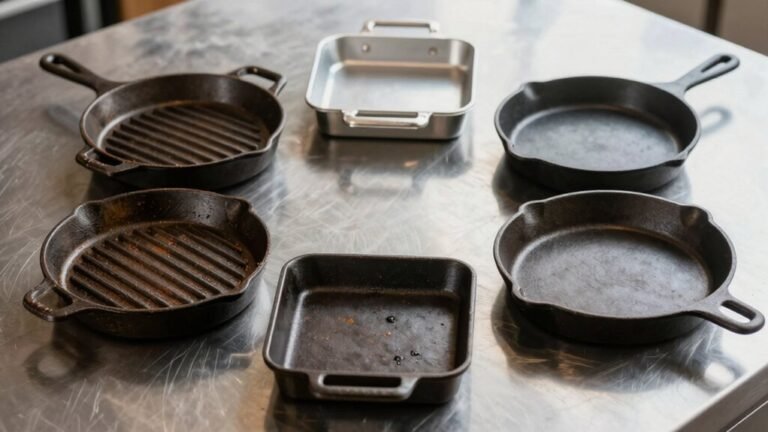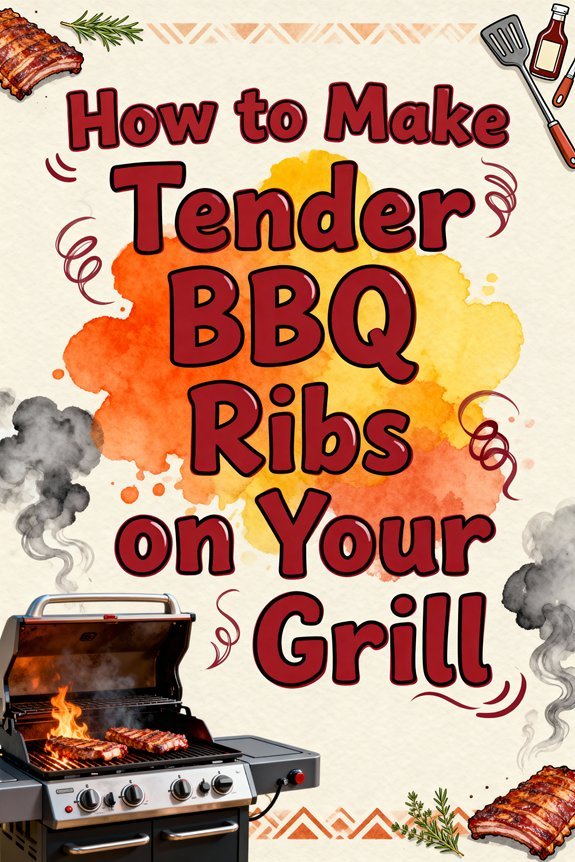To grill perfect shrimp on your stovetop, start with a quality ridged grill pan preheated over medium-high heat. Pat your shrimp dry and season them with salt, pepper, and your preferred spices. Arrange them in a single layer and sear for 2-3 minutes per side until they form a loose “C” shape and turn pink with golden-brown searing marks. Watch for an opaque white color with pink accents – a telltale sign of perfectly grilled shrimp. Master these basics, and you’ll reveal endless serving possibilities.
Essential Tools and Ingredients for Stovetop Shrimp
To grill perfect shrimp on your stovetop, you’ll need five essential tools and a handful of key ingredients. Start with a quality grill pan – there are several grill pan options available, from cast iron to non-stick surfaces. Raised ridges design helps drain excess fat while creating distinctive grill marks on your shrimp. You’ll also need sturdy tongs, skewers, a cutting board, and kitchen towels for cleanup. The best cooking time is to cook shrimp 3-2 minutes per side for optimal doneness. Much like low and slow smoking, maintaining consistent heat is crucial for even cooking results.
For ingredients, select fresh or frozen shrimp that’s already peeled and deveined. Choose your preferred cooking oil – olive or canola work well. Basic seasonings should include salt, pepper, garlic powder, and paprika. Consider shrimp marinade variations to enhance flavor, such as citrus-based or herb-infused options. Don’t forget to keep lemon wedges on hand for serving. These tools and ingredients will guarantee you achieve perfectly grilled shrimp every time.
Preparing and Seasoning Your Shrimp
Before diving into the grilling process, proper shrimp preparation and seasoning will make or break your final dish. Start by sourcing high-quality shrimp, whether fresh or frozen, and verify they’re fully defrosted if using the latter. Pat them dry thoroughly with paper towels after cleaning and deveining to promote better searing. This under 15 minutes cooking method makes it perfect for busy weeknights. Similar to vacuum-sealed fish, properly stored shrimp helps maintain optimal freshness and flavor.
When it comes to seasoning techniques, begin with a base of kosher salt and black pepper. Just like achieving a golden brown crust on a perfect grilled cheese, you’ll want to enhance the natural flavors without overpowering them. For Mediterranean flair, combine garlic powder with Italian herbs, or create an Asian-inspired profile using soy sauce and ginger. Don’t forget the power of citrus – a touch of lemon zest brightens the dish. Remember that larger shrimp may need slightly more seasoning than smaller ones.
[affiai keyword=”seafood seasoning spices for shrimp” template=”carousel” count=”3″
Mastering the Perfect Sear
When you’re ready to achieve the perfect sear, proper heat management and timing become critical factors. Just like when grilling chicken quarters, maintaining a consistent temperature control is essential for even cooking. Similar to how a low and slow approach works for brisket, patience is key to achieving great results. Preheat your skillet over medium-high heat and choose an oil with a high smoke point, like avocado or grapeseed oil. Once the oil’s shimmering, arrange your shrimp in a single layer, ensuring they don’t overcrowd the pan. Flash-freezing leftovers helps preserve quality for up to 4 months.
Your sear timing should be about 2-3 minutes per side, allowing the shrimp to develop a golden, caramelized crust. Watch for the telltale “C” shape – it’s your signal for perfect doneness. Avoid flipping more than once, and don’t disturb the shrimp while they’re searing. Remove them promptly when they turn pink and opaque, as they’ll continue cooking slightly from residual heat. For extra flavor, finish with a pat of butter or a squeeze of citrus.
Signs of Perfectly Cooked Shrimp
Mastering the art of perfectly cooked shrimp relies on recognizing key visual and physical indicators. Your primary doneness indicators include the shrimp’s color transformation from translucent gray to opaque white with pink accents, and its characteristic curl shape. mushiness signals uneven cooking and a need to adjust heat or cooking time.
Watch for a loose “C” shape, which signals perfect doneness, while a tight “O” shape indicates overcooking. The exterior should show slight browning with a pinkish hue, while the flesh remains slightly translucent before you remove it from heat. When pressed, the texture should feel firm yet springy. Similar to achieving the perfect indirect heat method for prime rib, maintaining consistent temperature control is crucial for evenly cooked shrimp. Just as low and slow smoking yields tender chicken, gentle heat application ensures shrimp stay succulent.
For precise results, use an instant-read thermometer to achieve internal temperatures between 120°F and 130°F. Remember that cooking times are brief, so stay vigilant – you’ll want to remove the shrimp just before full opacity to account for carryover cooking.
Finishing Touches and Serving Suggestions
To elevate your grilled shrimp from excellent to exceptional, the right finishing touches and serving choices make all the difference. When garnishing shrimp, sprinkle fresh herbs like parsley or cilantro for color contrast, and add citrus wedges for both visual appeal and flavor enhancement. You’ll want to serve your shrimp over beds of rice or quinoa to absorb the delicious sauces, or present them on a large platter for family-style dining. For optimal freshness, store leftovers within 2 days.
Pair your grilled shrimp with classic cocktail sauce, zesty aioli, or spicy chipotle mayo for dipping. Consider serving shrimp as part of tacos, grain bowls, or alongside grilled vegetables. Like perfectly grilled scallops, allowing your shrimp to rest briefly after cooking helps enhance their final texture and flavor. A refreshing pasta salad makes an ideal accompaniment, featuring crisp vegetables and light dressing that won’t overpower the seafood. For added dimension, finish with a drizzle of high-quality olive oil and a sprinkle of smoked paprika or fresh cracked pepper just before serving.
[affiai keyword=”seafood serving platters and dipping sauces” template=”carousel” count=”3″







